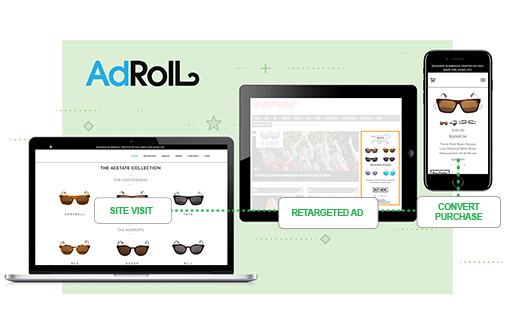Ad retargeting is good for your bottom line — it can boost your click-through rate, help you get more impressions and clinch those almost-sales. But before we get ahead of ourselves, let’s make sure that you have a solid understanding of how retargeting works.
In simple terms, it’s when you use advertising to target users who have already visited your website, viewed a product or are otherwise engaged in your brand. In other words, it’s when consumers see an ad for a product or service that they’ve already viewed online.
One of the best ways to set your strategy in motion is with the AdRoll platform, which tracks user behavior for future retargeting. Essentially, AdRoll follows your website visitors by placing anonymous retargeting cookies into their browsers, and it’s extremely easy to manage on your end.

All you have to do is place a JavaScript tag in the footer of your website. This little piece of code can help you make more conversions, encouraging users to finally pull the “checkout” trigger.
You can take AdRoll’s technology a step further with the help of Springbot’s Online Ad tools, which include the ability to create dynamic ads. This feature, along with others in our cache, can help you reach a wider audience and make more sales with AdRoll APIs. When our stores use social media and web retargeting together, they see about a 73 percent increase in conversions. Retargeting is good, but bundling it with Springbot and AdRoll is even better.
Ad Remarketing vs. Ad Retargeting
One important thing to note when getting started with ad retargeting is that, while it’s similar to ad remarketing, there are some differences.
Ad Remarketing reminds users of a specific product via e-mail. For example, your ad remarketing strategy might include sending consumers an email or wish-list reminder to combat cart abandonment or get them to re-engage with your site. Ad Retargeting, on the other hand, generally refers to the act of using targeted display ads to remind users of a specific product or brand.
Retargeting with Personalization in Mind
You probably already know that you need to create ads that are personalized in order to capture the highest conversion rate. With retargeting, it all comes down to creating dynamic ads. Unlike static ads, which generally do not change from person to person, dynamic ads factor in your user data so that you can provide the most relevant, marketing message possible to each customer.
Dynamic ads are also measurably more effective than their unchanging counterparts; they can double your click-through rate and lower your cost-per-acquisition by half compared with static ads.
Another way to personalize your retargeting strategy is through dynamic Facebook ads, which show up to users on Facebook after they’ve viewed a certain product on your website. If this sounds complicated, don’t worry! Springbot and AdRoll take the guesswork out of dynamic ads, so they’re extremely easy to use.
Retargeting Metrics to Determine Success
With all this promise of improved conversions, you have to ask yourself whether the return on investment (ROI) of retargeting is worthwhile. The good news is that there are several retargeting metrics you can use to determine the success of your retargeting campaign and whether it’s worth more of an investment. Springbot’s analytics will help you uncover plenty of useful data about consumer behavior with regard to retargeting.
- Click-through Conversions — This metric shows the number of people that click on an ad and then make a purchase. Measuring your click-through conversion rate is the clearest and most illuminating way to gauge success.
- View–Through Conversions — View-through conversions refer to users who saw a retargeted ad and then returned to the product or website later through a different marketing channel, not through the ad itself. Make sure to measure how long it took the user to return to your site after seeing the ad.
- Returning Visitors — Perhaps it’s obvious, but one of the best ways to gauge whether your retargeting campaign is working is to measure your returning visitors versus new visitors. A higher return visitor rate likely means your retargeting is working.
Springbot is an expert when it comes to helping businesses successfully retarget their goods or services to the right audience. If you have any questions at all or would like more information on how to implement these tools to your benefit, don’t hesitate to get in touch!





